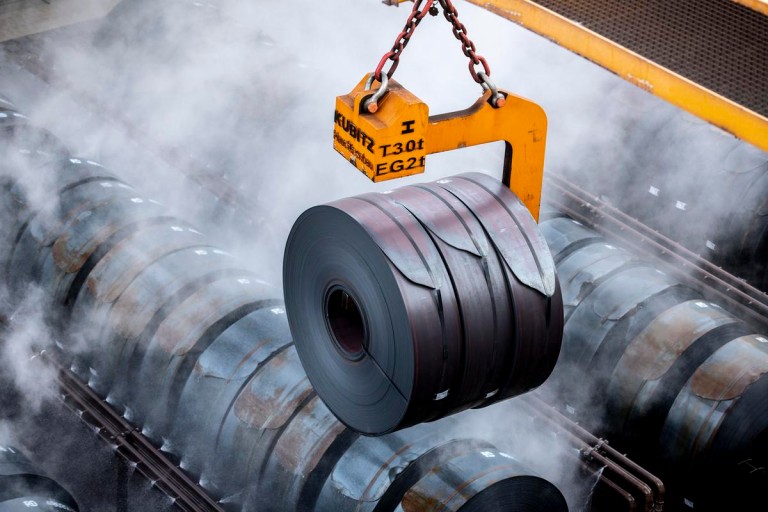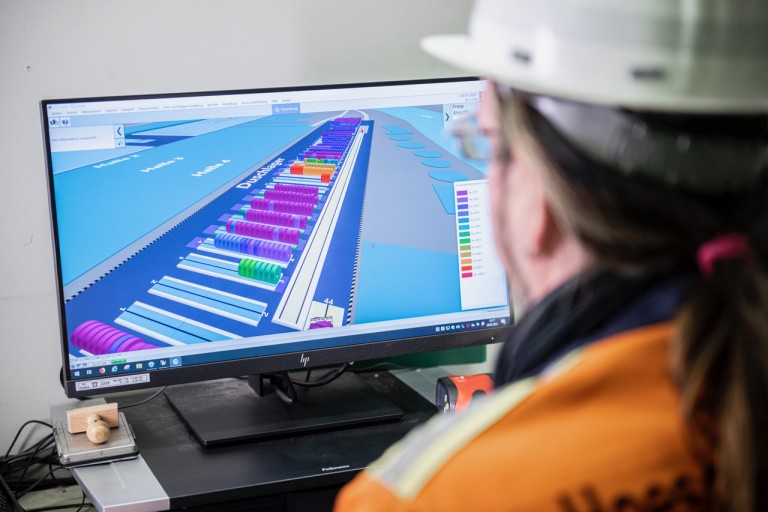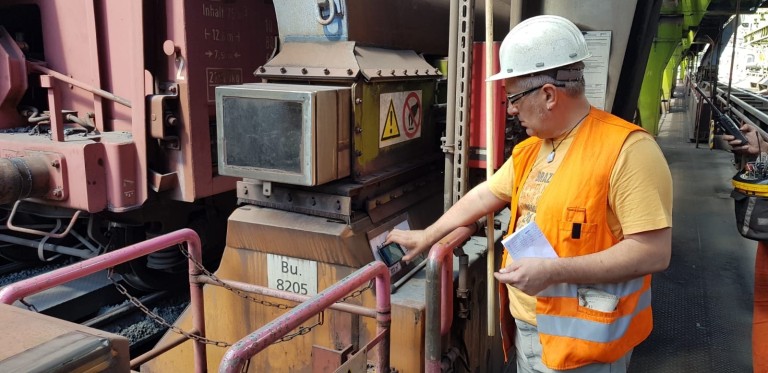Intelligent and connected processes
smart factory
They count steps, set off alarms, measure temperature: Smart sensors dictate our daily work routine. These miniature measuring devices also perform important monitoring and control functions in thyssenkrupp Steel’s plants.
The X-ray vision of the sensor doesn’t miss even the smallest of bumps: It measures the thickness of the sheets as they whisk by with a degree of accuracy down to microns. It does this by evaluating how much radiation the material absorbs. This information is then combined with information on the composition of the alloy and analyzed – a smart contactless and delay-free method of detecting variations in thickness and maintaining tolerances.
The radiometric sensor is one of hundreds of thousands that ensure that all processes run smoothly in thyssenkrupp Steel’s plants and that every sheet produced meets the customer’s specific requirements. “In addition to dimensions, a lot of other data is collected, such as the color shades of paint or furnace temperatures. We’re also particularly interested in the various mechanical properties, such as tensile strengths or yield strengths,” explains Daniel Overlöper, who, together with his colleagues, bundles the information from the sensors and collates it for structured analysis. Hot strip mill 2 in Duisburg alone processes more than 1.2 billion measurements every day, in addition to up to 16,500 metric tons of steel slabs.
These small measuring devices have been in use for decades in the highly automated plants of the steel industry. They are robust and well adapted to their environment: for example, to enable them to pick up reliable data despite the extreme heat that prevails in the blast furnace or the fine mist in the hot strip cooling section. But are they smart? And fit to play a leading role in Industry 4.0? “Fit, yes, but smart in the true sense of the word, no”, says Volker Lang, Head of Digital Transformation & Innovation at thyssenkrupp Steel. “But that doesn’t mean we have to ‘retool’ everything. We can make our production plant smart by networking the sensor technology already installed.” Digital solutions such as edge computing or IoT gateways can play a key role here.
The principle is similar to that used in the applications that almost 40 percent of the German population know from their own smart home: Users, for example, set a certain temperature and the smart radiators regulate themselves by receiving and evaluating measurement data. For this purpose, the heating system and the sensor must be networked by means of a control unit. The same principle holds true in the hot rolling mill, where constant measurement and control of the temperature is also of key importance because it has a crucial influence on the mechanical properties of the steel sheets produced.
Smart networking and the fact that industrial sensors have not only become significantly smaller but also cheaper have fundamentally changed the way data is handled. “As part of our digitalization measures, we have increased the number of sensors installed many times over,” Daniel Overlöper tells us. “At the same time, powerful processors ensure that the huge volumes of data generated are processed in real time.” Take tensile strength as an example: Typically, this parameter, like other mechanical properties, is measured post-production by taking an actual physical sample of the material. In addition, the desired material properties can now also be monitored continuously during production with the aid of additional sensors. The data collected is fed into a mathematical model, together with other process parameters recorded in real time.
This allows results to be simulated in advance. “Although this is not yet a viable alternative to destructive sampling, it already helps the staff in the control room to better understand the quality-relevant parameters and control them accordingly.” Avoiding disruptions
In conjunction with systematic data evaluation, sensors are also able to detect problems at an early stage and increase plant availability. “The technology has improved significantly in the area of vibration measurement, for example,” notes Overlöper. “Today’s sensors are smaller, more accurate, and cheaper. As a result, we have retrofitted them all over the place and are now able to detect very early on if something is not running smoothly.”
Last but not least, thyssenkrupp Steel uses smart sensor technology to allow us to exploit resources more efficiently and therefore more sustainably. Gas and electricity flows are already being measured today. “It is technically feasible to refine this sensor technology so that we could also use it to record specific energy consumption levels in real time,” explains Volker Lang. Digital networking is an important component of an efficient and sustainable steel production process, which can be traced transparently right back to the smelter.
Precision Steel in Hohenlimburg is considered a perfect example of digitization of the rolling mill process. Now the team headed by Ulrich Schneppe and Thomas Westermann has reached another milestone: The shower cooling area, where steel coils are cooled off before passing on to the pickling line, was integrated into the existing digital structure. This allows to further reduce the lead times of the hot-rolled precision strip significantly.
There are working environments that you prefer to look at from a distance - the shower cooling area in the Hohenlimburg hot rolling mill is one of them. A forklift driver transports the steel coils, which have a temperature of up to 600 degrees Celsius, to the outdoor storage area, where they are cooled down by means of round cone nozzles and then transported on to the pickling line. The time when the desired temperature is reached is now displayed on the screen. Since November 2020, the shower cooling area has existed as a "digital twin," a mathematical image of the real location. The data model on which it is based provides all relevant information at the click of a mouse and sends a message as soon as a coil is ready for further transport. The stacker is also integrated into the material tracking system (MTS) in real time. This makes it possible to track at any time where a specific coil is currently located on the plant premises.
The water shower cooling has several advantages over the conventional air cooling process. “We were able to reduce the lead times significantly, from 72 on average to only five to six hours“, says Thomas Westermann, Head of Maintenance and Logistics who has played an instrumental role in the implementation of the new process. Quality defects like corrosion pits can be avoided by the controlled cooling process. Another important feature is that the coils are cooled down in the shower cooling area and the storage area preceding the pickling line only to the extent that is optimal for the pickling process.
The basis for this - apart from the consolidation of various process data - is a self-developed mathematical model on the basis of which each individual ring "knows" when it reaches the optimum temperature. The globally unique method thus has two important benefits: it optimizes warehouse logistics and increases productivity in the manufacturing process. "Something like this only works if you have a reliable database," explains Head of IT Ulrich Schneppe. "This is the result of many years of detail work, it's a bit like cleaning out the cellar. But now the data tracking and tracing helps us to link process parameters even more precisely to the material flow, and to continuously get better also in future.”
At the same time, the new digital project follows the path toward a fully connected steelworks and creates the conditions for giving customers extensive scope of action in the future. Under the catchword “Rolling as a service“, customers are already today involved in determining what’s next up on Precision Steel’s rolling program. Short lead times are essential to ensure that this business model also works without large inventories.
”Until now, we lacked the digital link between the rolling mill and the material tracking systems of our two pickling lines. We have significantly reduced this gap with the MWS shower cooling area", explains Ulrich Schneppe. In the coming months, the storage area upstream of the pickling line will be the last area to be integrated. After that, the entire logistic process can be digitally mapped, controlled and managed, from slab loading in Duisburg down to pickling in Hohenlimburg.
The digital warehouse management system also meets with a positive response from the internal staff. It enables forklift drivers to spot or deposit coils more quickly and provides information about where the load can be deposited safely – a benefit for occupational safety and health. “The more often you use the digital tools, the more you appreciate their benefits“, says Thomas Westermann. “It starts with the fact that I can optimize my own logistic processes and ends with the controlling process, where I can get information on material stocks, turnover rates and tied up capital at the click of a button.“ “Cleaning out the basement" has paid off.
A key objective of digital transformation is to evaluate product and machine data across different process stages. Data Analytics allow to predict material properties like, for instance, thickness variations, roughness or strength more precisely and to meet tolerances more accurately. To this end, hundreds of thousands of sensors record quality and production data throughout the entire flat steel process chain, thus creating the basis for controlling and analyzing production processes in real time. The Big Data Squad, an interdisciplinary team, develops mathematical models on the basis of these data. One of these models has been used to control the skin pass rolling mill of the hot dip galvanizing line 8 in Dormtund for one year. It ensures that the system now meets the targeted roughness values of the steel strips even more accurately. “Previously, the plant operator set the machine mainly based on his experience. Now our model allows to automatically make the right setting for any order parameter,“ explains Yavuz Dogan from the Big Data Squad. The advantage: Already now, the digitized control system meets the tolerance range more precisely and creates the basis for readjusting the operation mode online, if necessary, which leads to further quality improvement.
At the same time, an interdisciplinary team conducts pilot projects in the field of horizontal networking, which are coordinated by the Innovation Department. In this context, the main question is: What product data from the steel processing operations could also be used for the customers in future? For Lothar Patberg, Head of Innovation at thyssenkrupp Steel, the advantages of such data exchange are obvious: “Data are already available after the production of the coils. In future, the customer could not only track the current status of his order. He could also obtain selected quality data from the production operations, which would enable him to adjust his own processes before the coils are delivered“. These considerations are pointing the way ahead for one of the central projects of thyssenkrupp Steel: to link data from different process stages in such a way to create an as exact as possible digital replica of the production. The birth of these digital twins and the associated data transparency would not only be an advantage for the downstream stages of the value chain. It would also have a self-reinforcing effect. Lothar Patberg: “Digital replica help us to better understand our processes and to identify and eliminate potential sources of error and default risks. Ultimately, the digitization of our value chain will thus lead to a further improvement of both our delivery performance and the quality of our materials“.
Germany's largest factory railway with 87 locomotives, approx. 2,000 wagons and around 300 kilometres of rail network is now more digital. It is the crucial transport route for raw materials and products on our site and beyond. In a current #DigitalLab - here, employees from different departments work intensively and in short sprints on the digital transformation of the company -, a train driver app has now been developed that simplifies communication between order planners and locomotive drivers, thus improving our internal logistics and reducing the plant's own delivery bottlenecks.
Up to now, the exchange has mainly taken place via radiotelephony. The prototype was ready for field testing in just four weeks, including cloud-based system architecture. Now, dispatchers and train drivers can view their orders and track occupancy at any time and send their messages directly via the app.
Today, a new app for our blast furnances in Duisburg, ensures significantly more process stability and efficiency. The app records in real time every single wagon that supplies our blast furnaces with raw materials. In particular, it displays all trains and their wagons loaded with raw materials on their way to the blast furnaces on our plant site. When a wagon is discharged into the designated raw material bunker, an employee scans the a NFC tag at the bunker - the system immediately reports this to all relevant systems.
Previously, each charging process was documented manually. Since several trains are often discharged one after the other, it was no longer possible to record the exact time and therefore no current stocks could be retrieved. In a nutshell: the balance sheet diverged.
A further advantage of the new app is the digital inventory, which takes place at the beginning of each shift. What was previously time-consuming and costly documented with a piece of paper and pencil is now scanned using an NFC tag. Finally, the quantity that still fits into the bunker is selected via slider. After confirmation, the current stocks are immediately reported to the relevant systems.
Contact

Volker Lang
Head of Digital Transformation & Innovation
thyssenkrupp Steel Europe AG
Kaiser-Wilhelm-Strasse 100
47166 Duisburg
Telephone: +49 (0)203 52-47749
Send email
thyssenkrupp Steel Europe
Marcus van Marwick
Head of Communications
Telephone: +49 203 52 41005
Send email





